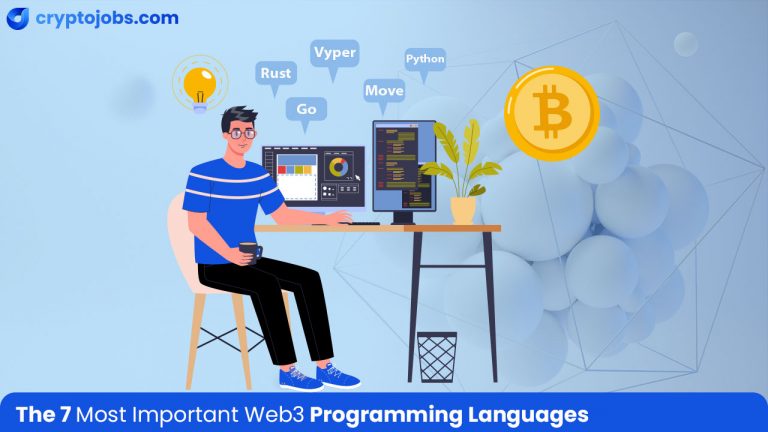
The 7 Most Important Web3 Programming Languages
- cryptojobs.com
- November 27, 2023
- All Posts, Web3
- Web3, web3 programming languages
- 0 Comments
Web3 is reshaping the digital landscape by introducing decentralized technologies and blockchain-based systems. As this new era unfolds, the demand for skilled developers is skyrocketing. In the realm of Web3, programming languages play a crucial role in shaping the decentralized applications and smart contracts that power this innovative space.
Web3 developer jobs are notorious for being hard to get because blockchain companies have raised the standard. Your average developer with minimum programming language exposure cannot survive the fast-paced blockchain world. Anyone who wishes to become a part of the Web3 ecosystem will need to have command over certain programming languages that have become an industry standard over the years.
Here, we explore the seven most important Web3 programming languages that developers should consider mastering if they want to thrive in their Web3 developer job.
Solidity
The crown jewel of smart contract development, Solidity is the primary language for crafting smart contracts on the Ethereum blockchain. In fact, Ethereum’s prominence in the Web3 space has solidified Solidity’s position as a must-learn language for developers who are just venturing into decentralized applications.
The syntax of Solidity resembles JavaScript’s syntax, which makes it much easier to learn, especially for developers who are familiar with Web2 development practices. It allows for the creation of modular and reusable code because it supports object-oriented programming.
This is very beneficial to the developers and sets the stage for further work in non-fungible tokens (NFT) and Decentralized Finance (De-Fi). Solidity’s dominance in the Ethereum ecosystem makes it a key language for anyone serious about Web3 development.
You may like: Tips to Become a Successful NFT Artist for Beginners
Rust
Rust gained popularity in the Web3 space after its launch in 2015. Thanks to its association with the Polkadot network, it is one of the widely used programming languages in the Web3 industry. Developed by Parity Technologies, Rust offers strong memory guarantees without sacrificing performance.
This makes it well-suited for building scalable and secure blockchain applications. Polkadot has a unique approach to interoperability between blockchains and requires a language that can handle complex tasks with efficiency. Rust does exactly that!
Rust puts emphasis on performance, and that positions it as a preferred choice for developers within the Polkadot ecosystem. As the network continues to grow, Rust remains a crucial language in the toolkit of Web3 developers.
Python
Versatile and known for its readability, Python has carved its niche in the Web3 space. While not as specialized as some of the other programming languages mentioned on this list, Python finds utility in various aspects of decentralized development. It supports every aspect of development, from scripting to the backend.
Python’s extensive library ecosystem and widespread adoption in the broader software development community make it a versatile choice for blockchain projects. Developers using Python can leverage frameworks like Flask or Django to build robust backend services for Web3 applications.
Its versatility positions Python as a valuable language for those seeking flexibility across different facets of decentralized development.
Go (Golang)
Golang or Go has become synonymous with the development of blockchain infrastructure. Its simplicity, efficiency, and support for concurrent programming make it an excellent choice for crafting the backend components of decentralized systems.
Many important projects use Go as their primary language. Binance Smart Chain and Geth by Ethereum use Go for all of their implementations. This programming language uses some revolutionary features, such as static typing and garbage collection. Such features contribute to streamlined development processes, improve the scalability of blockchain networks, and enhance the maintainability of said networks.
As the demand for robust blockchain infrastructure grows, proficiency in Go becomes increasingly valuable for Web3 developer jobs.
JavaScript
JavaScript is a foundational language for Web3 development, particularly on the front end. Dynamic and interactive user interfaces are becoming increasingly necessary with the growth of decentralized applications, and JavaScript is essential to meeting this need.
Developers can use frameworks like Node.js, React.js, and Vue.js, along with Web3.js and ethers.js, to create simple and engaging user interfaces for decentralized applications. JavaScript’s ubiquity in Web3 development and its extensive community support make it an essential language for anyone venturing into Web3 front-end development.
Move
Developed by Facebook’s Libra (renamed Diem), Move is designed specifically for blockchain programming needs. Move is an executable bytecode language that ensures the safety and security of smart contracts on the Libra Blockchain.
Move’s focus on preventing vulnerabilities and ensuring robustness through static verification makes it a unique player in the Web3 landscape. While Libra’s evolution into Diem has seen shifts in its approach, Move remains a language of interest for those exploring blockchain solutions within the Diem ecosystem.
Vyper
Often considered to be Solidity’s sibling, Vyper is a Python-based language designed for crafting smart contracts on the Ethereum blockchain. With an emphasis on simplicity and security, Vyper provides an alternative to Solidity, aiming to create more readable and auditable smart contract codes.
While Solidity has a stronghold on Ethereum smart contract development, Vyper’s user-friendly syntax and security-centric design make it an interesting choice for developers who prioritize ease of understanding and reduced risk of vulnerabilities in their smart contracts.
You may like: Smart Contracts 101: Understanding the Backbone of Web3
As Ethereum evolves, Vyper may find increased adoption within the Ethereum ecosystem.
Final Thoughts
The Web3 landscape is dynamic and multifaceted. Each programming language offers some unique advantages in specific contexts. Developers embarking on Web3 journeys must carefully choose languages based on the blockchain platforms and projects they aim to work on. Whether it’s the performance prowess of Rust, the solidity of Solidity, or the versatility of Python, mastering the right programming languages is very important for success in the Web3 landscape. As Web3 continues to evolve, staying attuned to new languages and tools will be crucial for developers who are aspiring to succeed in Web3 jobs.




